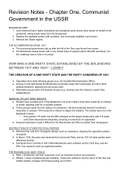Revision Notes - Chapter One, Communist
Government in the USSR
BOLSHEVIK AIMS
1. Lenin believed that a highly centralised and disciplined party should seize power on behalf of the
proletariat, taking power away from the bourgeoisie.
2. Replace the capitalist system with socialism, and eventually establish communism.
3. Remove the Tsarist regime.
THE OCTOBER REVOLUTION, 1917
● The provisional government (set up after the fall of the Tsar) was forced from power.
● The Bolsheviks seized power with a very limited base of support (about 300,000 members), but
the challenge was to hold on to power.
HOW WAS A ONE-PARTY STATE ESTABLISHED BY THE BOLSHEVIKS
BETWEEN 1917 AND 1924? - LENIN!!!
THE CREATION OF A ONE PARTY STATE AND THE PARTY CONGRESS OF 1921
● Opposition from other left-wing groups (e.g. the Socialist Revolutionaries (SRs))
● Groups on the right feared the Bolsheviks would take away their businesses and deny them
political freedoms, attacking the old social order.
● Nationalist groups within the Russian Empire (e.g. Ukraine) saw the chance to assert their
independence.
REMOVAL OF LEFT WING GROUPS
● Shared many socialist aims of the Bolsehviks, but Lenin made it clear there would be no sharing
of power, rejecting calls for a socialist coalition.
● These groups hoped that the calling of a parliament, the democratically elected Constituent
Assembly, in January 1918 would be a chance to regain the initiative. The results were not in the
Bolshevik’s favour.
○ They gained 175 seats, but the SRs emerged as the largest single party with 410 seats.
○ Lenin then dissolved the Assembly, ensuring no real forum for opposition.
● Imposed restrictions made it difficult for the Mensheviks and SRs to publish their newspapers.
DESTRUCTION OF OTHER POLITICAL PARTIES
● Removed the vote from ‘bourgeois classes’ such as employers, stripping the opposition parties
of support.
● In March 1918, the party was renamed the Communist Party, and by 1921 all other parties were
effectively banned.
● During the first 3 months of 1921 5000 Mensheviks were arrested, and by 1922 they, and the
SRs, had ceased to exist as organised parties.
THE RUSSIAN CIVIL WAR, 1918-21
● Reds = Bolsheviks and their supporters such as industrial workers and peasants.
● Whites = range of political groups including - those who wished to see the return of the Tsar and
military leaders unhappy with Russia pulling out of WWI.
, ● After the signing of the Treaty of Brest-Litovsk, which ended Russia’s involvement in WWI,
opposition to the Bolsheviks mounted, resulting in a series of military campaigns.
● It was not until the end of 1920 that the Bolsheviks had defeated the Whites and secured
Communist rule over the country.
○ This was largely achieved due to the better organisation of the Reds, in military,
economic, and political terms. The only thing that united the Whites was their desire to
get rid of the Bolsheviks, so co-operation was limited.
KEY RESULTS:
● Power was now firmly in the hands of the government and party leadership based in Moscow, as
a result of the state becoming highly centralised due to the demands of the civil war.
● The Bolsheviks made extensive use of terror against their political opponents, setting the tone for
later development.
● Huge growth in party membership, from 300,000 at the end of 1917 to 730,000 by 1921.
However, this posed a threat to Party stability, and so a ban on the formation of factions was put
forward by Lenin at the Congress of 1921 and the penalty for breaking this rule was expulsion.
THE NATURE OF GOVERNMENT UNDER LENIN
THE APPARATUS OF GOVERNMENT
● Organisations that represented the proletariat, such as trade unions and factory committees,
were brought under Bolshevik rule and then sidelined to be headed by the Sovnarkum.
● The Sovnarkum was the Council of People’s Commissars and were, in theory, responsible for
making key decisions and giving government orders. It contained about 20 members, who were
elected by the Central Executive Committee.
● The Central Executive Committee was elected by the Congress of Soviets, and its task was to
oversee the work of the government.
● The All-Russian Congress of Soviets was the supreme law making body of the state, made up of
members elected by local soviets.
PARTY CONTROL OVER THE STATE
● Politburo = made key decisions affecting policy, made up of 7-9 leading members of the
Bolshevik Party. Most important.
● The Central Committee = 30-40 members chosen by the Party Congress to represent its
members; it was supposed to make key decisions but this was increasingly delegated to the
Politburo.
● Party Congress = made up of representatives from local party branches, who could be very
powerful especially those who headed branches in key cities as they provided significant power
bases. E.g. Zinoviev was head of the Moscow branch, which played an important part in the
power struggle to succeed Lenin.
DEMOCRATIC CENTRALISM
● The wishes of workers could be expressed through the above structures, that would take their
concerns to the higher levels of government, for decisions to be made in the ‘interests of the
people’, and passed down to local level for implementation.
● However in reality, the system turned representative bodies into rubber stamping bodies that
merely carried out orders given by the centre.




